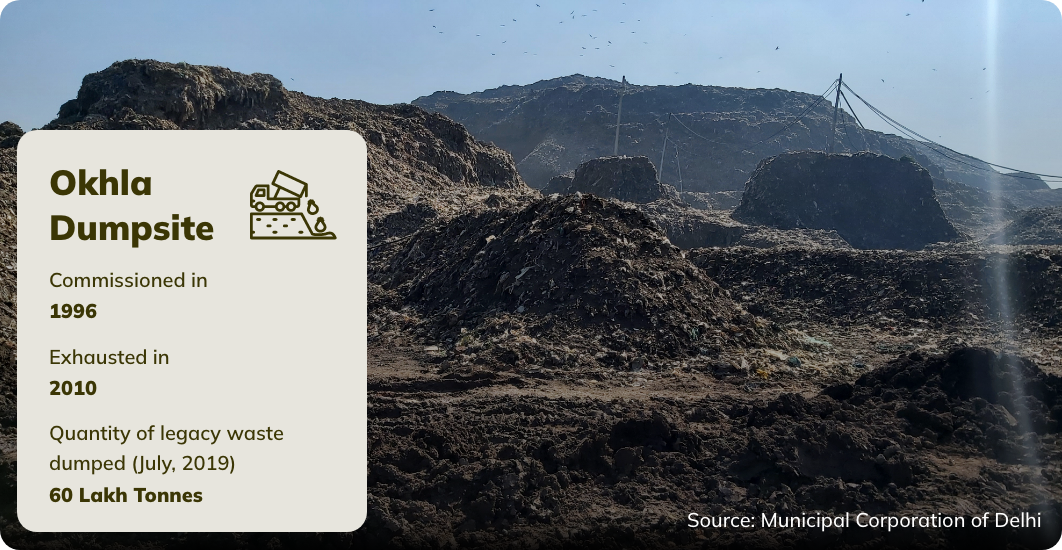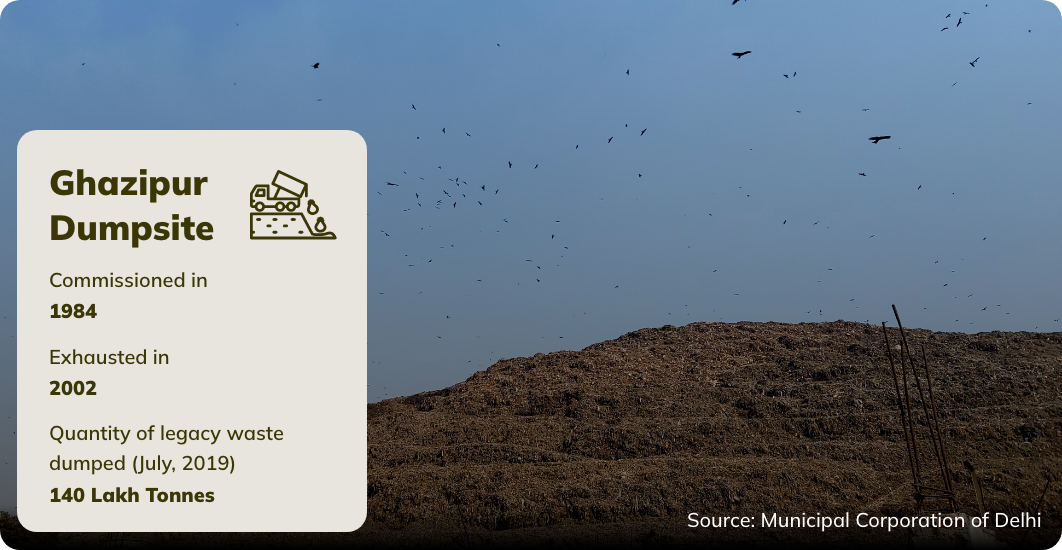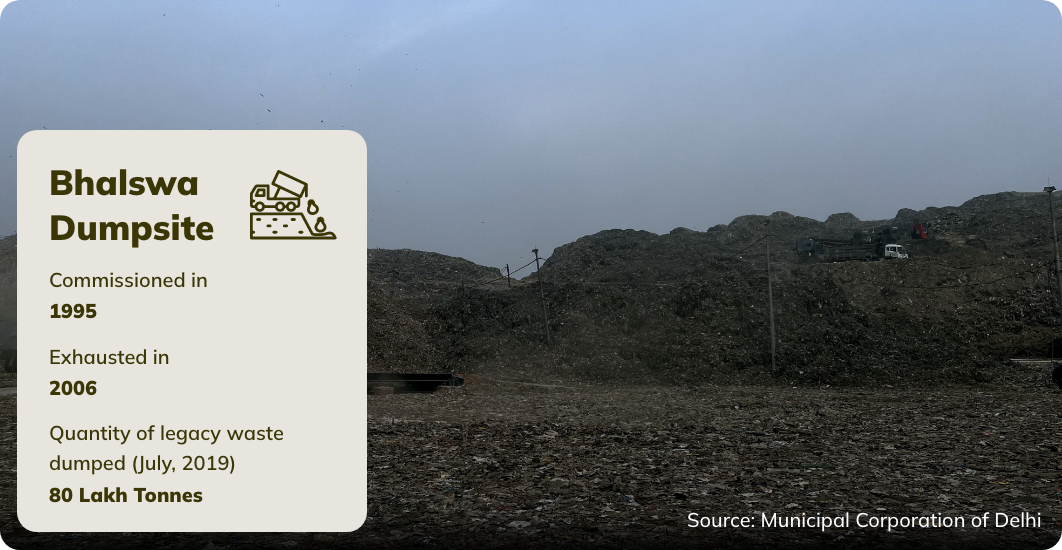New Delhi: Savera was eight when her family migrated to Delhi from Kolkata in search of a better life. Unable to find a good job, her father moved to Ghazipur, close to a “garbage mountain” where they all learned how to collect waste and make a living.
“When we climb to the top of the dumpsite, we carry our death in our hands”, says Savera, who is now a 32-year-old fatigued woman with three children.
We don’t know by the end of the day whether we will come back alive or not. All we know is that we have to take money home for our kids and put food on the table.
Savera is among hundreds of informal waste collectors who live off the garbage mountain. They secretly enter the Ghazipur dumpsite, spread across 72 acres of land, climb the hills of trash and spend their day segregating waste and collecting valuables, which is essentially waste that can be sold to recyclers to earn some money.
Also Read: Living In The Shadows Of Asia’s Largest Garbage Mountain, The Ghazipur Landfill
As per the information shared by the Municipal Corporation of Delhi, the city generates 11,332 tonnes of Municipal Solid Waste per day. This includes 11,000 TPD (Tonnes Per Day) from the Municipal Corporation of Delhi (East, South and North Delhi Municipal Corporation), 260 TPD generated by the New Delhi Municipal Council and 72 TPD by the Delhi Cantonment Board.
“Hundred per cent of the waste generated is collected. Door-to-door collection means the auto tipper which has two main compartments – green for wet waste and blue for dry waste – and a small black box at the back, goes to every house or residential society,” Dinesh Yadav, Chief Engineer at the Department of Environmental Management, at the Municipal Corporation of Delhi (MCD) tells NDTV.
MCD has 12 zones with one contractor for each zone. The collected waste goes to Fixed Compactor Transfer Stations (FCTS) – a garbage compressing system that facilitates the transport of garbage to sanitary landfill sites – and Material Recovery Facilities (MRFs) for the recovery of recyclables. What the MRFs collect goes to waste-to-energy plants, for composting, and to dumpsites.
According to the Solid Waste Management Rules 2016, waste should be segregated at source but not everyone in Delhi practices it, says Mr. Yadav.
Of the 11,332 TPD of fresh waste, 6,078.5 TPD is processed at four waste-to-energy plants, 622.4 TPD is processed at composters, biogas plants, organic waste convertors and compost pits, 271 TPD is recycled through 170 Material Recovery Facilities (MRFs). And the remaining 4,360 TPD is disposed of at the dumpsites.
Ghazipur dumpsite is one of the three dumpsites in the national capital Delhi. The other two are Okhla and Bhalswa dumpsites.
Dumpsites: Health And Environmental Hazard
On April 8, 2016, the Ministry Of Environment, Forest and Climate Change notified the Solid Waste Management Rules 2016 to lay a solid framework for scientific waste management of waste across urban settlements. The rules apply to all sorts of waste generators: households, event organisers, street vendors, Resident Welfare Associations and Market Associations, gated communities having an area of more than 5,000 square metres, and hotels and restaurants.
Also Read: Solid Waste Management In India: The Challenge Of Growing Mountains Of Garbage – Landfills
The Solid Waste Management Rules 2016 define “dump sites” as “a land utilised by the local body for the disposal of solid waste without following the principles of sanitary land filling.”
Now, what is sanitary landfilling? The rules describe it as,
The final and safe disposal of residual solid waste and inert wastes on land in a facility designed with protective measures against pollution of ground water, surface water and fugitive air dust, wind-blown litter, bad odour, fire hazard, animal menace, bird menace, pests or rodents, greenhouse gas emissions, persistent organic pollutants slope instability and erosion.
Confused about what this means in layman’s language?
“While sanitary landfills are scientific structures or containment systems which are engineered and constructed in a way to isolate waste from the surrounding environment, dumpsites are mere pieces of land without any mechanism for pollution control,” says Dr. Richa Singh, Deputy Programme Manager, MSW (Municipal Solid Waste) team, Centre for Science and Environment.
She adds that sanitary landfills have barriers of high-density polyethylene and mechanisms to collect and treat leachate (contaminated liquid generated when water percolates through waste), alongwith the ability to collect landfill gas, which primarily consists of methane and treat that as well.
“Living around dump sites comes with health challenges as people in close vicinity are exposed to gases like the colourless and odorless Methane, trace gases like H2S (Hydrogen Sulfide), as well as high levels of Particulate Matter and Ammonia,” says Dr. Singh. These gases are carcinogenic in nature. Long-term exposure to these gases can result in respiratory disorders, and at times it can lead to cancer as well.
On dumpsites, while biodegradable or wet waste decomposes over time, the anaerobic decomposition (breakdown of organic waste in the absence of oxygen) of organic waste generates methane gas, which is flammable and generates heat. That’s the reason why dumpsites in Delhi, especially in summer, often catch fire. If not fire, then these are always smoldering in patches, says Dr. Singh.

Smoke continues to billow out at Bhalswa dumpsite, days after a fire that broke out on April 26, 2022
As an interim solution (till the remediation of all the legacy waste is done), a gas collection and treatment system for landfill gases is required. Moreover, landfilling of biodegradable and combustible waste should not be done in the first place to prevent the leachate and landfill gas issue.
Also Read: Solid Waste Management In India: The Great Garbage Challenge
According to the data received from Delhi Fire Services, between 2019 and 2022, the Department received 33 fire calls each from Bhalswa and Okhla dumpsite and 23 from Ghazipur.
In March 2020, the National Green Tribunal (NGT) formed a committee comprising the Central Pollution Control Board (CPCB), National Environmental Engineering Research Institute, and IIT Delhi to prepare a report on the “Assessment of the amount of damage to environment on account of dumpsites in Delhi”. As per the report prepared by the joint committee in January 2021, the three dumpsites have collectively caused nearly Rs. 450 crore in damage to the environment. The study has assessed the ecological damage caused due to Bhalswa dumpsite at Rs 155.9 crore, Okhla at Rs 151.1 crore and Ghazipur at Rs 142.5 crore.
Delhi’s Efforts To Clear Up Legacy Waste
Currently, these dumpsites appear to be like hills in the middle of a bustling metropolis. The garbage mountains in Ghazipur and Bhalswa continue to receive fresh waste regularly and a strong stench engulfs the surroundings.
Also Read: What Went Wrong With Asia’s Largest Dumpsite – Ghazipur And Delhi’s Waste Management Programme?
In an effort to clear up the dumpsite, the waste dumping has stopped at the Okhla site but the other two continue to receive fresh municipal solid waste on a regular basis.
The Solid Waste Management (SWM) Rules, 2016 urge local authorities to “investigate and analyse all old open dumpsites and existing operational dumpsites for their potential of biomining and bio-remediation and where ever feasible, take necessary actions to bio-mine or bio-remediate the sites.”
Bio-remediation and Bio-mining of Dumpsites:
It refers to the excavation of old dumped waste and making windrow of legacy waste. Followed by stabilisation of the waste through bio-remediation that is the exposure of all the waste to air along with the use of composting bio-cultures. And then, screening of the stabilised waste to recover all valuable resources followed by its sustainable management through recycling, co-processing, road making etc.
Source: Central Pollution Control Board

The oldest dumpsite in Ghazipur was commissioned in 1984 and crossed the permissible height of 20m in 2002. It has been overflowing since then and stands at around 40 meters, as per the MCD. Similarly, Bhalswa dumpsite, started in 1995, exceeded its capacity in 2006 and Okhla dumpsite commissioned in 1996 was declared exhausted in 2010.
Also Read: Landfills: A Big Burden On Delhi’s Chest
As per the data received from the MCD, 280 lakh tonnes of legacy waste has been dumped on the three dumpsites as of July 2019, with 140 lakh tonnes on the Ghazipur site alone.
The three dumpsites in Delhi have been ticking time bombs with burgeoning waste.
Keeping up with the SWM Rules, the MCD decided to opt for bio-mining of legacy waste. On November 3, 2022, the MCD awarded tenders to three companies to process and dispose of 30 lakh tonnes of legacy waste at each of the three sites in 18 months that is by May 2024. When this target is met, the contract will be renewed for additional 15 lakh MTs.
Sudhakara Infratech is responsible for managing legacy waste at Ghazipur, GreenTech Environ Management for the Okhla site and Alfa Therm Limited for Bhalswa.
“In our agreement, there is an incentive mechanism. If any of the contractors achieve the bio-mining target before the deadline, they will be incentivised,” Mr. Yadav told NDTV.
The three companies have adopted tromelling – the process of sieving the waste through trommel machines and segregating it into three categories – to sort the legacy waste. Team Banega Swasth India visited the Okhla dumpsite where 40.88 per cent (24.53 lakh tonnes) of the legacy waste (45 lakh tonnes) has been bio-mined as on January 31, 2023.
“The first step is to bio-remediate the waste by using bio-culture. This is to decompose the wet waste. Following this, we practice bio-mining using Klemen screening machines we have got from Germany,” says Ramakant Burman, CEO of GreenTech Environ Management.

Trommel machine used to segregate the waste into three categories – inert waste, construction and demolition (C&D) waste, and a segregated combustible fraction (SCF)
Trommels are used to segregate waste into three categories – inert waste, construction and demolition (C&D) waste, and a segregated combustible fraction (SCF). At Okhla dumpsite, 80-85 per cent of the legacy waste is inert which is being utilised by the National Highways Authority of India (NHAI) in various road construction projects. Industries having boilers compatible with a segregated combustible fraction (SCF) take that waste to use as fuel. The C&D waste is being utilised in construction industries.

Screening machine being used at the Okhla dumpsite to segregate construction and demolition waste from RDF
“It’s a waste to wealth project,” says Mr. Burman with pride.
Mr. Yadav from MCD said that the long-term plan is to reclaim the land by clearing up all three dumpsites and eventually convert it into sanitary landfills.
Since 2019, a total of 69.64 lakh tonnes of legacy waste has been bio-mined at three sites. This means 24.87 per cent of the 280 lakh tonnes of waste dumped has been removed as on January 31, 2023. If all three contractors achieve the target of removing 90 lakh tonnes collectively by May 2024, even then roughly half of the piled up waste will remain on these sites to be addressed. And not to forget that the dumping of fresh waste on a daily basis will continue.
According to the calculations done by Dr. Singh, Delhi will require five to six years to remediate legacy waste.
“The cumulative installed capacity of the trommels at Delhi’s dumpsites is reportedly 22,000 tonnes per day. If we consider that there are nearly 245 working days in a year (excluding three months of monsoons), to clear 280 lakh tonnes of legacy waste (dumped as of July 2019), Delhi will require five to six years to remediate all three sites provided that no fresh waste is getting dumped there,” Dr. Singh says.
However, the Delhi government is being ambitious about clearing all the dumpsites as early as possible. The state government is targeting to remove the three garbage mountains in two years and is offering Rs. 850 crore for flattening the sites. During the Delhi Government’s budget presentation on March 22, Finance Minister Kailash Gahlot announced the ambitious deadline for clearing all three dumpsites by the end of 2024. He said that the Okhla dumpsite will be removed by December 2023, Bhalswa by March 2024 and Ghazipur by December 2024.
Interestingly, the Delhi government, led by Aam Aadmi Party (AAP), fought the MCD elections in December 2022 on the promise of clearing up all three dumpsites. Now that AAP has won the municipal elections and is in control of MCD, NDTV asked an AAP representative about the plan to clear up the garbage and what is needed in terms of resources and infrastructure to get rid of the legacy waste.
“There is no magic bullet. All of our urban centers are going through a big crisis of waste,” says Reena Gupta, Advisor, Government of Delhi. “We have to follow three steps – reduce the amount of waste we generate, segregate and dispose of properly.”
Ms. Gupta says even though she segregates her waste, the moment it is collected by a waste picker, it gets mixed.
The way the contracts are designed, companies that collect waste get paid by weight. It is in the contractor’s interest to mix wet and dry waste and increase the weight of the waste collected. So, the first thing we are going to do is to look at all the contracts signed by erstwhile three MCDs (East, North, South).
The key is segregation and decentralised management of waste. This means, the first level of waste segregation has to happen at the household or waste generation level. Then after collection at the Resident Welfare Association (RWA) level and then at the ward level, another round of segregation needs to be practised.
If we practice waste segregation, wet waste, which is, biodegradable in nature, can be composted or converted into biogas.
“The ultra-pure form of biogas is bio CNG, which is practised by Indore, India’s cleanest city, as per Swachh Survekshan. Dry waste can be recycled. For now, sanitary waste can be sent to bio-medical waste incinerators. And, domestic hazardous waste to common hazardous waste management facilities”, says Dr. Singh.
In the process, rejects like drain silt, road dust, or residue solid waste, which doesn’t have any value – only that should be disposed of, ideally into the sanitary or engineered landfill.
NDTV’s Banega Swasth India team asked Delhi Chief Minister, Arvind Kejriwal about the lack of implementation of the segregation at source in Delhi, something that is mandated under SWM rules.
“Waste segregation should happen at the source and at the household level. Segregation isn’t practised by some households as it is difficult to overnight change the culture of a city. The waste is segregated after being picked up from the households,” said CM Kejriwal.
“We plan to create composting area in the MCD parks so that the person who comes to collect garbage or even individuals and RWAs, have a place where they can give waste for composting. A lot of training needs to happen – training of RWAs, mobilisation of citizens of Delhi, so that we get it in our culture that we have to reduce, compost and recycle,” says Ms Gupta. She further added, “Importantly, we have to create scientific landfill sites. There is no place in Delhi.”
The Urgency To Clear Up Dumpsites
On March 3, Delhi Chief Minister Arvind Kejriwal visited the Okhla dumpsite to take stock of the legacy waste clearing up work.
“The bio-mining capacity at Okhla stands at 17,000 MT but we can dispose of only 4,000-4,500 MT of waste daily. As a result of this, we are unable to utilise the bio-mining capacity at full strength. From April, the waste disposal capacity will be increased to 10,000 MT and 15,000 MT from June. With increased capacity, we will be able to meet our deadline by December or January,” he said.
आज ओखला कूड़े के पहाड़ का दौरा किया। इसे मई 2024 तक साफ़ करने का टार्गेट है। लेकिन हम कोशिश करेंगे इसे इस साल दिसंबर तक साफ़ कर दें। pic.twitter.com/ILYaa3EyVK
— Arvind Kejriwal (@ArvindKejriwal) March 3, 2023
On March 16, CM Kejriwal also visited the Bhalswa dumpsite where he said that of the 80 lakh tonnes of waste dumped at Bhalswa, 30 lakh tonnes have been cleared over the last two and a half years or so. By December 2023, another 30 lakh tonnes of waste will be removed and the remaining by March-April 2024. He added,
The initial target was to remove 6,500 tonnes of waste per day, but on Wednesday (March 15), 9,000 tonnes was removed. By the end of this month, 12,000 tonnes of waste will be removed every day.
आज भलस्वा लैंडफिल साइट का दौरा किया। यहाँ कूड़े के पहाड़ को हटाने का काम चल रहा है, उसके पूरे प्रोसेस को देखा।
यहाँ से 50 लाख MT कूड़ा अगले साल मार्च तक हटाने का टार्गेट है। दोगुनी स्पीड से काम चल रहा है। जल्द ही दिल्ली को कूड़ा मुक्त करेंगे। pic.twitter.com/HNVZyI0qm3
— Arvind Kejriwal (@ArvindKejriwal) March 16, 2023
Additionally, the major focus of the Swachh Bharat Mission (Urban) 2.0 [SBM (U) 2.0] launched on October 1, 2021, is to make cities garbage-free. SBM-U 2.0 focuses on solid waste management through segregation at the source and management of garbage through scientific processes, like dumpsite remediation that is the removal of waste that has accumulated on dumpsites over the years. Under this plan, 2026 is the deadline to remediate all legacy dumpsites.
Also Read: A Road To Garbage-Free City: How Can Cities Manage Their Waste In A Sustainable Manner
Waste Workers Brigade Living Off Dumpsites
As Delhi tries to reduce the discarding of fresh waste on dumpsites and transit to technologies like Waste to Energy (WTE) plants, what will happen to the people who live off these mountains of garbage? For instance, the waste collected from the East Zone used to go to the Ghazipur dumpsite but a huge chunk has been diverted to the Waste to Energy plant in Okhla. This has resulted in the loss of livelihood for people living around the dumpsite.
“As a kid, I would find and collect plastic, steel, metal and other valuable items from the garbage,” says Savera. “The waste coming here has been reduced by over 60 per cent. Earlier we would earn Rs. 500 to Rs. 600 a day, but now it is a challenge to earn Rs. 500 in two days.”
Now that her family income has halved, Savera is clueless about where to go in search of work. She still makes a trip to the dumpsite with the hope of finding some waste of value. Saddened by the proposed closure of the dumpsite, she says,
The government should have provided us an alternative source of livelihood. We are poor. We don’t have savings.
Team Banega Swasth India asked CM Kejriwal about his government’s plan to provide an alternative source of livelihood for waste workers. He said,
I don’t think there is any systematic plan. Let me find out.
Also Read: The Human And Health Cost Of Delhi’s Garbage Mountains And Waste Crisis
This report was written and produced as part of a media skills development program delivered by Thomson Reuters Foundation. The content is the sole responsibility of the author and the publisher.
NDTV – Dettol have been working towards a clean and healthy India since 2014 via the Banega Swachh India initiative, which is helmed by Campaign Ambassador Amitabh Bachchan. The campaign aims to highlight the inter-dependency of humans and the environment, and of humans on one another with the focus on One Health, One Planet, One Future – Leaving No One Behind. It stresses on the need to take care of, and consider, everyone’s health in India – especially vulnerable communities – the LGBTQ population, indigenous people, India’s different tribes, ethnic and linguistic minorities, people with disabilities, migrants, geographically remote populations, gender and sexual minorities. In wake of the current COVID-19 pandemic, the need for WASH (Water, Sanitation and Hygiene) is reaffirmed as handwashing is one of the ways to prevent Coronavirus infection and other diseases. The campaign will continue to raise awareness on the same along with focussing on the importance of nutrition and healthcare for women and children, fight malnutrition, mental wellbeing, self care, science and health, adolescent health & gender awareness. Along with the health of people, the campaign has realised the need to also take care of the health of the eco-system. Our environment is fragile due to human activity, which is not only over-exploiting available resources, but also generating immense pollution as a result of using and extracting those resources. The imbalance has also led to immense biodiversity loss that has caused one of the biggest threats to human survival – climate change. It has now been described as a “code red for humanity.” The campaign will continue to cover issues like air pollution, waste management, plastic ban, manual scavenging and sanitation workers and menstrual hygiene. Banega Swasth India will also be taking forward the dream of Swasth Bharat, the campaign feels that only a Swachh or clean India where toilets are used and open defecation free (ODF) status achieved as part of the Swachh Bharat Abhiyan launched by Prime Minister Narendra Modi in 2014, can eradicate diseases like diahorrea and the country can become a Swasth or healthy India.





































